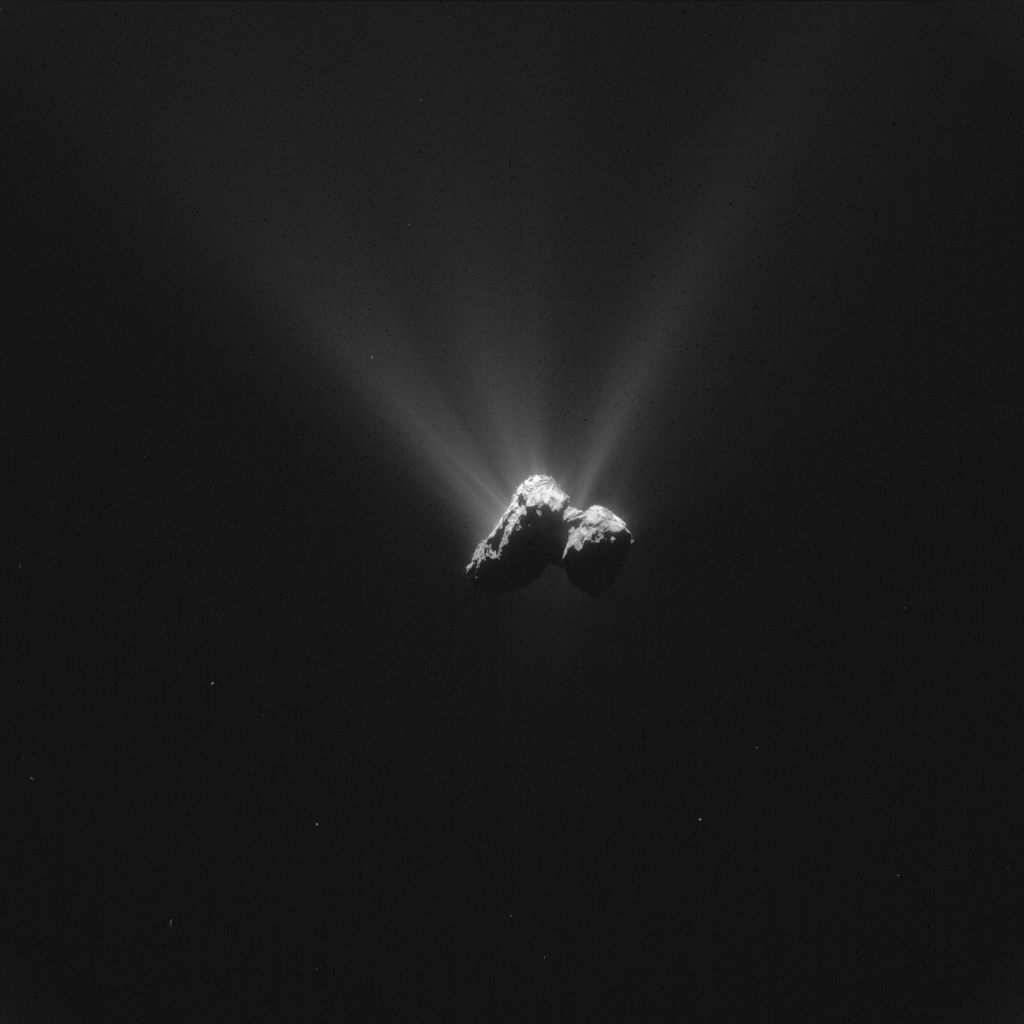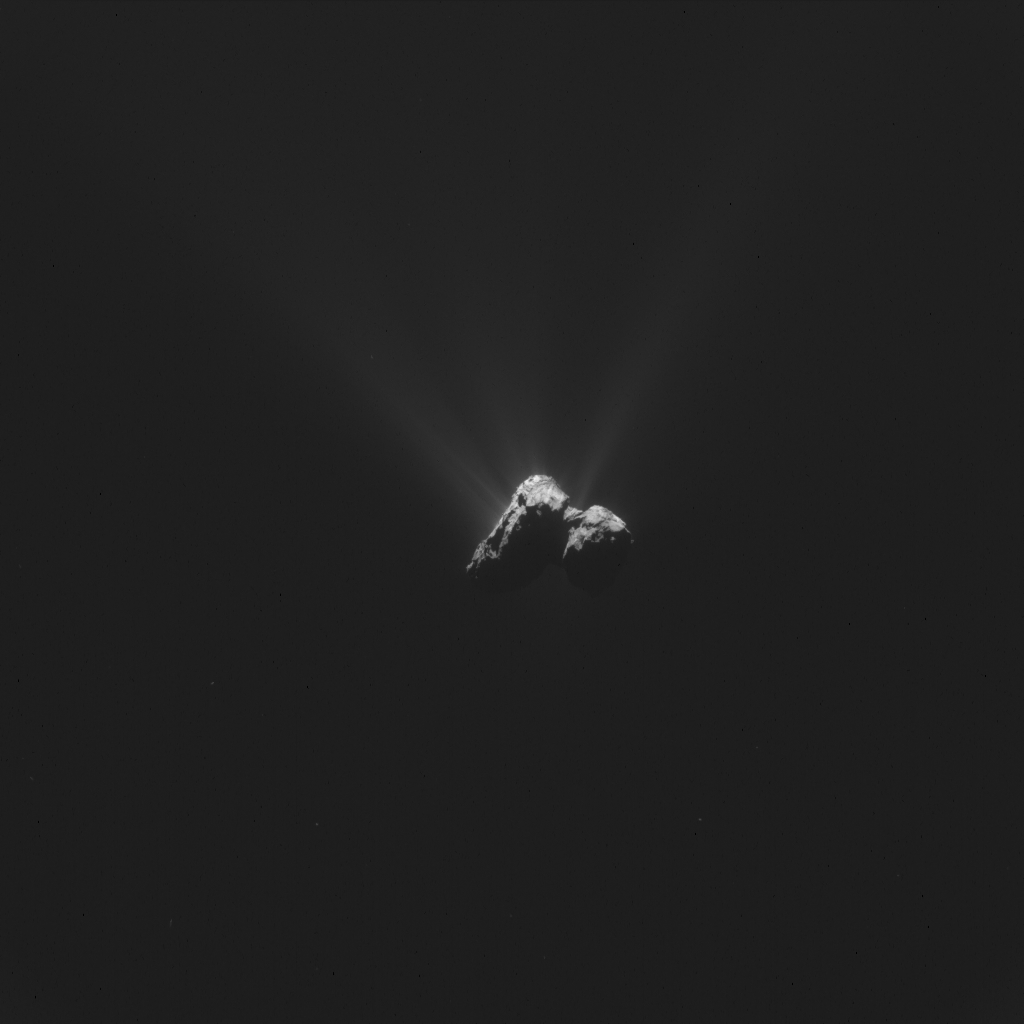Today’s CometWatch entry was taken three days after the perihelion of Comet 67P/Churyumov-Gerasimenko, on 16 August 2015. At the time, Rosetta was 331 km from the comet, which in turn was just over 186 million km from the Sun and almost 265 million km from Earth. This single frame NAVCAM image has a resolution of 28.2 m/pixel and it measures 28.9 km across.

NAVCAM image of Comet 67P/C-G taken on 16 August 2015, 331 km from the comet centre. Credits: ESA/Rosetta/NAVCAM – CC BY-SA IGO 3.0
With the large comet lobe pointing to the top left of the image and the small lobe to the bottom right, this spectacular view shows the activity of 67P/C-G just a few days after its closest approach to the Sun. The image has been processed in Lightroom to bring out the jets of dust streaming away from the nucleus.
It is interesting to compare today’s image with previous CometWatch entries, in particular those from 24 June and 14 July, in which the comet appears in a similar orientation. With that in mind, you might want to compare the images for evidence of increased activity. But take care to use the unprocessed images shown at the bottom of each CometWatch entry, not the Lightroom processed ones.
In today’s view, the elongated depression of Aten stands out on the large lobe, partly in shade; to its right, parts of the Aker and Khepry regions are also visible. On the small lobe, Bastet is well in sight while Ma’at and Hatmehit are cast in shadow, as are also Hapi on the neck and parts of Babi, Seth and Ash on the large lobe.
To find your way around the regions of 67P/C-G, you can explore the recently released interactive comet viewer.
The original 1024 x 1024 image of today’s CometWatch is provided below:










Discussion: 10 comments
First of all, Happy #Perihelion2015!!
I have heard some of the team members said the comet’s activity may increase for a few weeks after #Perihelion2015. Personally I think so. (which also makes me worry about possibility of contact between Rosetta & Philae when Philae is still capable of doing science.) But has Rosetta already got some data which shows that the comet’s activity has actually increased after #Perihelion2015, apart from man’s visual judgement from pictures?? Or is it too early to talk about it?!!
A revealing image Claudia and as you suggest worthy of comparison. I would however prefer the comparison with the images of the 29th July and the 12th August. Both of these earlier images displayed very bright narrow jets and neither image, we were informed, was processed to enhance the brightness of the jets. It was unnecessary.
Today’s ( unprocessed ) image is barely visible by comparison, a mere 10 days after perihelion. This was not what was widely predicted by ESA team members who expected a definite increase in activity ( and therefore jet intensity) after perihelion, because of a hypothesised heat sink effect.
From today’s image it looks as though the heat has been rapidly dissipated. As the comet is now moving away from the heat source, the Sun, would the ESA team members say that is it then. The candle is extinguished. They should because it can only collect decreasing radiant heat from now on.
Interesting then if the activity were to suddenly increase again. Would the same hypothesis be retained. We will have to wait and see.
You’ll get some hysteresis (delay) of the activity, since the heat takes some time to travel into deeper layers, and there may be some newly sun-exposed surface due to season, but then average activity will gradually slow down.
This doesn’t completely rule out later outbursts, but they’ll become less likely with distance from the Sun.
O.J.,
That would not be fair. There are no major outbursts on June 24 and July 14. JJust as there is not on this featured August 16 image.
Claudia’s selected comparison is very fair in that regard. As a result, we DO see increasing activity after Perihelion.
And for anyone directed here, please remember to always look at the bottom images, folks!
Your preference to compare to other undoctored images with major jets going off, would not be fair. Even if you mask out the major jets in Photoshop, “jet glow”, or scattered light will illuminate the dust all around it, making the remaining minor jets much more prominent. This fatally contaminates your preferred comparison experiment.
So I would suggest your last two paragraphs become moot, but then, your last paragraph turns it all around and if the activity increases, your theory is still covered, right?
It’s just not fair to throw any stuff out there that might convince a few followers at first blush, backed up with nothing more transparently teflon, “nothing sticks” maneuvering.
lets make it simple Ram.
29 July: very bright jet
12 August: very bright jet and base flare
13 August perihelion
16 August barely visible jet
all very close to the Sun
not expected from the sublimation hypothesis
And then,
August 22… Biggest explosion recorded yet!
https://blogs.esa.int/rosetta/2015/08/28/cometwatch-22-august-2/
Hi Gerald,
I don’t quite get your hysteresis theory, I can see residual heat, but not increasing residual heat penetrating further into the core to reach deeper ice that has not yet sublimated. Granted if a new layer of ice was exposed, not sure how if surface temperature is reducing, then sublimation may start increasing again.
Hi Dave, neglecting newly exposed surfaces due to seasonal changes, and just considering heat conduction:
(I presume), there is a compositional gradient in the subsurface of the comet. Deeper layers are richer in supervolatiles than shallow layers, since deeper layers have never been warmed up (by the Sun) to high temperatures.
As the mean solar illumination will be reducing with distance from the Sun, and for simplicity neglecting the diurnal changes near the very surface, we’ll get a temperature profile with very low temperature in the deep interior of the comet, say 30K, don’t nail me down to the exact value, it depends on the long-term orbital history of the comet.
Closer to the surface we get a gradual increase of the temperature. Near perihelion at daytime, the maximum temperature is at the very surface of the comet. But later, the surface cools down, with diurnal oscillations near the surface.
Below some shallow surface layer, the diurnal oscillations are averaged out, and just the longer-term mean surface temperature is relevant.
Since the mean surface temperature is decreasing with distance from the Sun, the highest temperature doesn’t necessarily stay near the surface.
More relevant is, however, that the deep interior is still colder than layers closer to the surface. The warmth hence continues to travel deeper into the comet even after perihelion.
The absolute temperatures there will still stay low in comparison to the maximum temperature at the surface near perihelion.
But since warmer layers still cover cold layers, those cold deeper layers are warmed.
Since the deep layers never have seen high temperatures, they are containing frozen supervolatiles. Some of them, particularly carbon monoxide and nitrogen, sublimate at temperatures below -200°C at low pressure, and may cause later outbursts.
As a feasible example for heat conduction, take a spoon, and put one side into hot water (the solar illumination analog), wait until the other end begins to warm up. Then put the hot side into cold water (less solar illumination). The other side of the spoon (outside the water) still grows warmer for some time.
In the comet analogy, the water just cools down gradually (gradual increase of distance from the Sun), stays hence still warmer than the other side of the spoon.
If the water initally had 90°C, later 70°C, despite cooling, that’s still sufficient to warm up the other end, and e.g. melt butter (the supervolatile analog), although not necessarily wax (as water ice analog), which would have been molten easily at 90°C (comet surface at perihelion analog) at the hot end of the spoon.
Hysteresis heat can’t go beyond sublimation line. So pressure build-up probably not related to ices, in this model.
ERRATA: Sorry Gerald, I’ve read your answer to Dave. I was wrong. Hysteresis heat can indeed sink beyond sublimation line, if transfered at a temp lower than the sublimation point. [Monday morning ‘haze’ at mind, shouldn’t write].